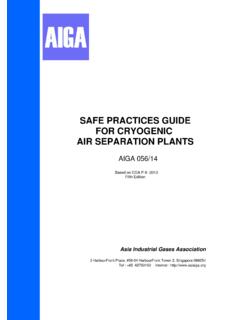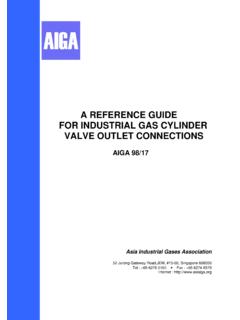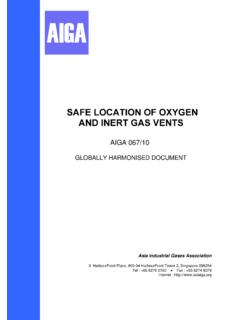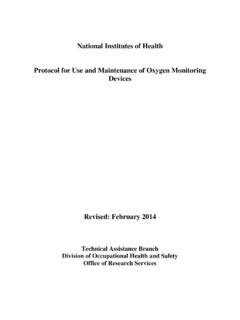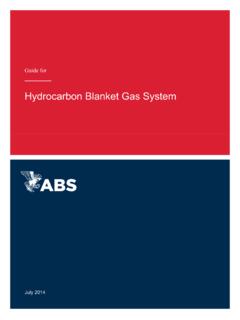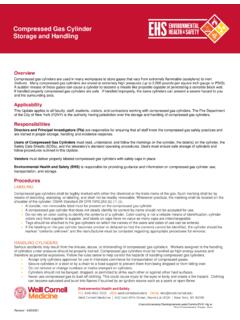Transcription of GUIDELINE FOR THE LOCATION OF OCCUPIED BUILDINGS IN ...
1 GUIDELINE FOR THE LOCATION OF OCCUPIED BUILDINGS IN INDUSTRIAL GAS PLANTS AIGA 093/16 Asia Industrial Gases Association 3 HarbourFront Place, #09-04 HarbourFront Tower 2, Singapore 099254 Tel : +65 6276 0160 Fax : +65 6274 9379 Internet : Reproduced with permission from Compressed Gases Association Inc. All rights reserved. ASIA INDUSTRIAL GASES ASSOCIATION 3 HarbourFront Place, #09-04 HarbourFront Tower 2, Singapore 099254 Tel: +65 62760160 Fax: +65 62749379 Internet: AIGA 093/16 GUIDELINES FOR THE LOCATION OF OCCUPIED BUILDINGS IN INDUSTRIAL GASES PLANTS As part of a programme of harmonization of industry standards, the Asia Industrial Gases Association (AIGA) has issued this publication 93, Guidelines for the LOCATION of OCCUPIED BUILDINGS in Industrial Gas Plants, jointly produced by members of the International Harmonisation Council and originally published by the Compressed Gas Association(CGA) as P-64-2014, Guidelines for the LOCATION of OCCUPIED BUILDINGS in Industrial Gas Plants.
2 This publication is intended as an international harmonized publication for the worldwide use and application by all members of the Asia Industrial Gases Association (AIGA), Compressed Gas Association (CGA), EIGA, and Japan Industrial and Medical Gases Association (JIMGA). Each association s technical content is identical, except for regional regulatory requirements and minor changes in formatting and spelling. Disclaimer All publications of AIGA or bearing AIGA s name contain information, including Codes of Practice, safety procedures and other technical information that were obtained from sources believed by AIGA to be reliable and/ or based on technical information and experience currently available from members of AIGA and others at the date of the publication.
3 As such, we do not make any rep-resentation or warranty nor accept any liability as to the accuracy, completeness or correctness of the information contained in these publications. While AIGA recommends that its members refer to or use its publications, such reference to or use thereof by its members or third parties is purely voluntary and not binding. AIGA or its members make no guarantee of the results and assume no liability or responsibility in connection with the reference to or use of information or suggestions contained in AIGA s publications. AIGA AIGA 093/16 Contents Page 1 Introduction.
4 1 2 Scope .. 1 3 Definitions .. 2 4 Building siting study methodologies .. 4 General information .. 4 Introduction to consequence-based analysis .. 4 Introduction to risk-based analysis .. 5 Introduction to overpressure concepts .. 5 Portable versus permanent BUILDINGS .. 6 5 Selection of BUILDINGS for consideration in the building siting study .. 7 Preliminary considerations .. 7 BUILDINGS that should be included in a building siting study .. 7 BUILDINGS that may be excluded from a building siting study .. 8 6 Selection of scenarios for consideration in the building siting study .. 8 Introduction to scenarios .. 8 Vapour cloud explosion .. 8 Process deviations.
5 10 Pressure vessel mechanical failure .. 11 Exposure from neighbouring facilities .. 13 7 Determining the consequences of included scenarios .. 13 Decision on the type of analysis .. 13 Simplified approach for locating portable BUILDINGS .. 13 Consequence-based methodology .. 14 Risk-based methodology .. 16 8 Documentation and revalidation of building siting study .. 20 Documentation .. 20 Revalidation .. 20 Management of change .. 20 9 References .. 20 10 Additional references .. 23 Figure Figure 1 Pressure wave illustration .. 6 Appendices Appendix A Occupant vulnerability probabilities .. 24 Appendix B Overpressure versus distance curves for vapour cloud explosions.
6 26 Appendix C Gamma factors for various materials in ASU and HYCO plants .. 27 Appendix D Pressure volume energy .. 29 Appendix E Worked example for a HYCO plant .. 31 Appendices Figures Figure A-1 Probability of occupant vulnerability in psi .. 24 AIGA. AIGA 093/16 Figure A-2 Probability of occupant vulnerability in mbar .. 25 Figure B-1 Side-on overpressure versus distance for hydrogen using multi-energy correlation at explosion strength = 5 .. 26 Figure B-2 Side-on overpressure versus distance for hydrogen using multi-energy correlation at explosion strength = 7.
7 26 Figure C-1 Gamma factors for typical industrial gas materials at +70 F, +1500 F, and 200 F .. 27 Figure C-2 Gamma factors for typical industrial gas materials at 123 C, +21 C, and +827 C .. 28 Figure D-1 Overpressure versus P V / (Gamma-1) factor for gases in psi and ft3 .. 29 Figure D-2 Overpressure versus P V / (Gamma-1) factor for gases in bar and m3 .. 29 Figure D-3 Overpressure versus P V / (Gamma-1) factor for 50% liquid full steam vessel in psi and ft3 .. 30 Figure D-4 Overpressure versus P V / (Gamma-1) factor for 50% liquid full steam vessel in bar and m3 .. 30 Figure E-1 HYCO plot example .. 31 Figure F-1 ASU plot example .. 38 Figure G-1 Risk assessment methodology flowchart.
8 43 Appendices Tables Table E-1 HYCO consequence-based analysis worked example .. 33 Table E-2 HYCO risk-based analysis worked example .. 36 Table F-1 ASU risk-based analysis worked example .. 40 AIGA. AIGA 093/16 1 1 Introduction Incidents have shown the need for the chemical industry to consider the LOCATION of both permanent and portable OCCUPIED BUILDINGS on chemical production facility sites. The ignition of flammable vapour released into a congested process area or pressure energy released from process equipment failures can impact personnel located inside these BUILDINGS .
9 Industry groups such as the American Petroleum Institute (API), the Center for Chemical Process Safety (CCPS), and the Chemical Industry Association (CIA) have developed guides to assist these industry companies in the safe LOCATION and design of OCCUPIED BUILDINGS to improve the safety of workers. In some regions, assessing the risk to occupants in BUILDINGS within air separation unit (ASU) facilities is not specifically required by regulations. This publication is intended to provide guidance specific to the industrial gas industry for the determination of LOCATION and design of both permanent and portable on-site OCCUPIED BUILDINGS to address the risks in ASU and HYCO plants.
10 The goal of this publication is to provide guidelines to: protect the building occupants so the building does not place the occupants at greater risk than employees located outside; and reduce the risk to employees not essential to the operation of the facility by locating such employees in a building that is either: away from the process; or reinforced and/or equipped to achieve comparable risk reduction to that achieved by distance alone. Risk management and process safety assessment are complex subjects. Technology for determining the loca-tion of OCCUPIED facility BUILDINGS is still evolving. Some aspects of this technology require the application of technical judgement as well as proven scientific methodologies.


